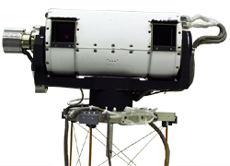 The Surface Stereo Imager (SSI) will create panoramas and characterize the general environment of the landing site. It is mounted on a mast approximately 1 meter high. When fully extended, the two eyes of the SSI will view the Martian surface from a height of about 2 meters, similar to the height of human eyes. The camera can take highly detailed images, allowing scientists to accurately measure the sizes of terrain features. With its array of filters, the camera will record the geological composition if the landing site, and the amounts of water and dust in the atmosphere. The Surface Stereo Imager (SSI) will create panoramas and characterize the general environment of the landing site. It is mounted on a mast approximately 1 meter high. When fully extended, the two eyes of the SSI will view the Martian surface from a height of about 2 meters, similar to the height of human eyes. The camera can take highly detailed images, allowing scientists to accurately measure the sizes of terrain features. With its array of filters, the camera will record the geological composition if the landing site, and the amounts of water and dust in the atmosphere.
The SSI is essentially a clone of the Imager for Mars Pathfinder (IMP). It is a multi-spectral imager accessing several wavelengths in the visible and near infrared. This multi-spectral capability, together with onboard calibration targets, will provide true-color images. Stereo imaging is made possible by focusing the dual optical lens systems onto a single detector.
The SSI will also provide imaging support for other science instruments, especially the RA and TEGA, as well as additional experiments. For example, magnets (provided by the Niels Bohr Institute) located on the lander deck were designed to collect dust. A special filter will enable the SSI to collect high-resolution images of the dust which collects on these magnets, enabling scientists to determine the abundance of magnetic components in the surface material.
The SSI was designed at the University of Arizona Lunar and Planetary Lab (LPL) under the direction of Peter Smith. H. Uwe Keller (Max Planck Institute for Aeronomy) and Eric DeJong (JPL) are Co-Investigators.

The SSI being compressed into its stowed position
|



















